Sowing the Seas: Ocean Farming Will Grow the Crops of the Future
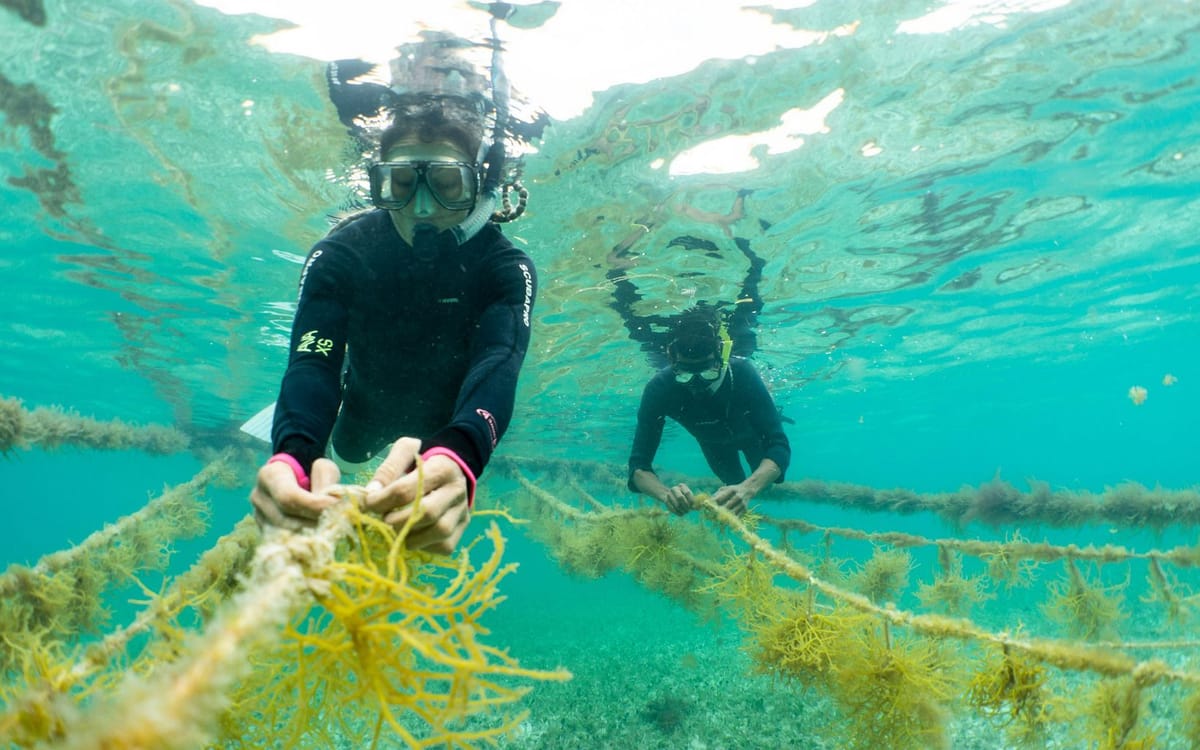
The Seaweed Revolution
Nurse sharks circle playfully in the brilliant blue water, sparkling in the bright Caribbean sun. Swimming nearby, I pop my head beneath the surface and enter a vibrant underwater world with colorful fish and corals. I swim through rows of ropes attached to buoys in a giant grid-like fashion. Neatly tied to the ropes are thick, chunky strands of red sea moss, swaying gently in the current.
I’m floating above a thriving seaweed farm.

Traditional seaweed harvesting has been practiced by cultures around the world for centuries. More robust methods of large-scale cultivation took root in Japan in the 20th century, paving the way for the now $16 billion dollar global seaweed industry encompassing sectors like food products, cosmetics, pharmaceuticals, and health supplements.
Other than food products like sushi wraps and seaweed chips, seaweed extracts are found in a number of common household products like toothpaste and plant-based milks.
Today, seaweed is also gaining attention for its potential role as a key player in the hunt for economically viable climate change solutions.
My journey is not just about an underwater garden, but a movement that’s changing lives and livelihoods. The Seaweed Revolution is sustainably growing our crops of the future.
What is Seaweed Farming?
Although much more common in Asian cultures, seaweed is a popular and nourishing food staple around the globe. It is farmed most prevalently in China, Philippines, Indonesia, South Korea, and Japan.
But the nutrient-rich sea plant is gaining popularity in the United States.
I first learned about the concept of farming seaweed from Bren Smith, a North American pioneer in the field. When I began writing about seaweed online, I featured Smith’s innovative ideas and sent him the article in a cold email.
To my surprise, he responded! We arranged a Zoom call, and I felt like I was meeting my own personal celebrity.
In Smith’s viral TedTalk from 2013, this charismatic Canadian shares his story of leaving school at the age of 14 to become a commercial fisherman. In Alaska, he became disheartened by the overfishing crisis and destructive practices of both deep-sea trawling and nearshore factory fish farming.
Smith discovered what the global fishing industry is hiding from us: our oceans are dying.
In just a single generation, our planet has gone from fully stocked seas to 90% depletion of commercial fish species such as cod, salmon, tuna, and anchovies.
As much as he loved being a fisherman, Smith turned away from the unsustainable industry and began the environmentally-friendlier practice of shellfish farming in northern Maine. This is where he learned he could also cultivate a seaweed called kelp on the lines of rope between his bags of mussels and clams.
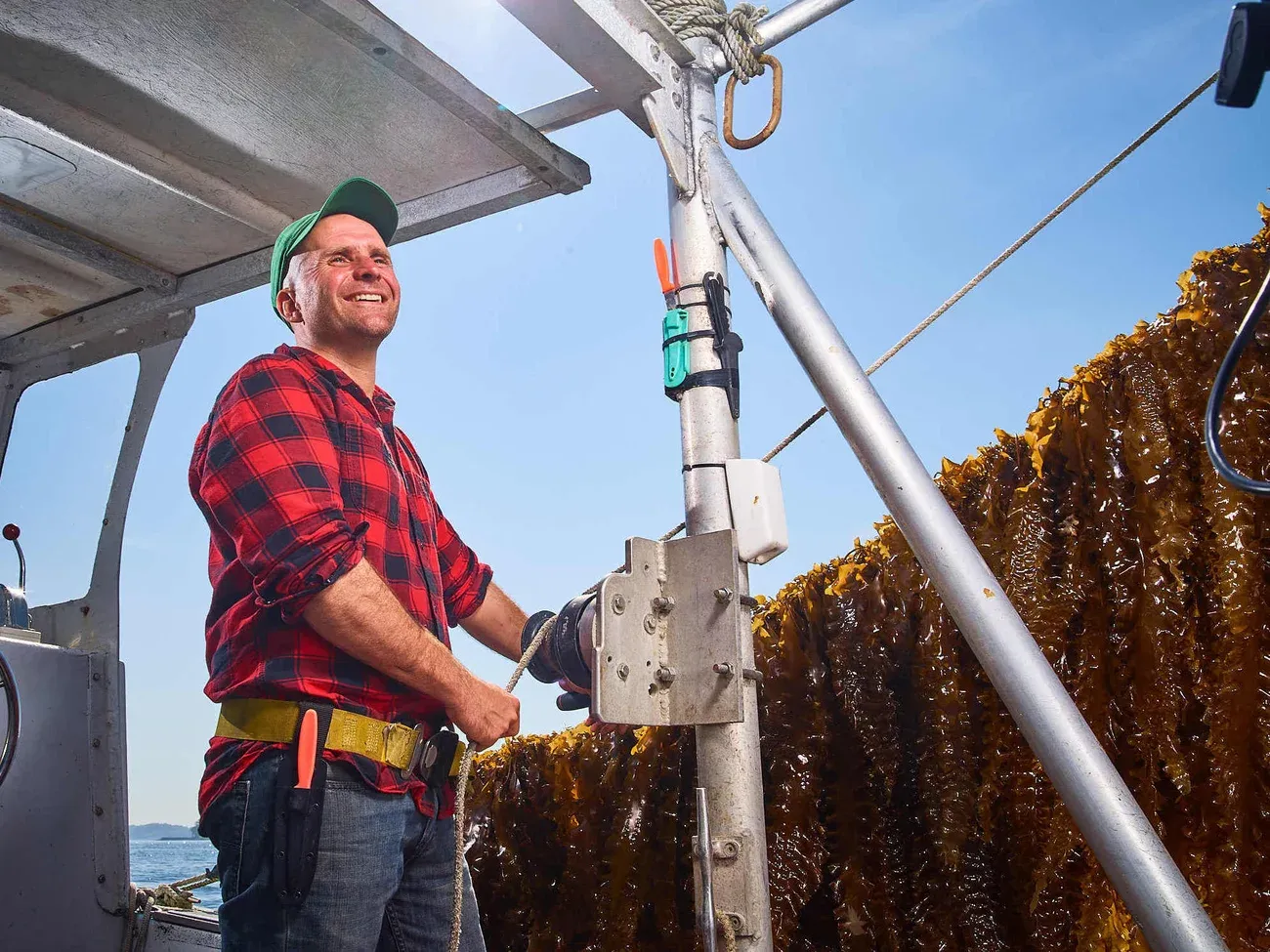
Growing kelp and crustaceans together allow them to naturally benefit each other which improves the health of an ocean farm, and Smith could sell the kelp for added income. It was a clear win-win.
In his book Eat Like A Fish, Smith talks about his approach to regenerative seaweed farming and teaches others how they too can become ocean farmers.
Sustainable Solutions in the Sea
Seaweed farming is remarkably sustainable.
Unlike traditional land crops, it needs no fresh water, fertilizers, or feeds.
Nearly a quarter of all human-induced greenhouse gas emissions is due to agricultural practices such as fermenting livestock, deforestation for land-use, and the energy costs of running large machinery or producing pesticides. When it comes to the carbon emissions of our foods, beef production is by far the largest emitter. The emissions to produce a single hamburger are equivalent to driving your car across town, or approximately 6 miles.
While global livestock contribute to nearly 15% of all greenhouse gas emissions, seaweed does the opposite, sequestering carbon dioxide to help mitigate climate change.
And although land plants also sequester carbon for growth, even crops like wheat contribute to global greenhouse gas emissions due to intensive farming practices. Seaweed's ability to sequester carbon effectively is widely recognized, but the exact numbers can be quite complex and are subject to ongoing research and methodology development. Recent studies suggest that on average, each kilogram of seaweed grown absorbs about 2 kilograms of CO2. On the other hand, for every kilogram of beef produced, approximately 60 kilograms of CO2 are emitted.
This makes seaweed one of the most environmentally friendly foods on the planet.
Underwater plants like seaweed do not erode soils or need chemically-induced fertilizers to grow in the ocean. Seaweed absorbs carbon dioxide during photosynthesis at a rate up to 50 times faster than terrestrial forests. The salt water provides the nutrients, buoyancy, transparency to sunlight, and carbon dioxide in a stable environment ideal for photosynthesis.
The Social Impacts of Farming Seaweed
It’s clear the environmental benefits of seaweed are profound, but what about the social aspects of the business?
After returning from my swim to the seaweed farm, I relaxed on the sandy shores of the Belizean coast, sipping a deliciously fruity and refreshing seaweed smoothie. On my visits to Belize, I learned of the profound impact this industry has–and could continue to have–on vulnerable communities facing the most immediate threats of the climate change crisis, like coastal flooding.
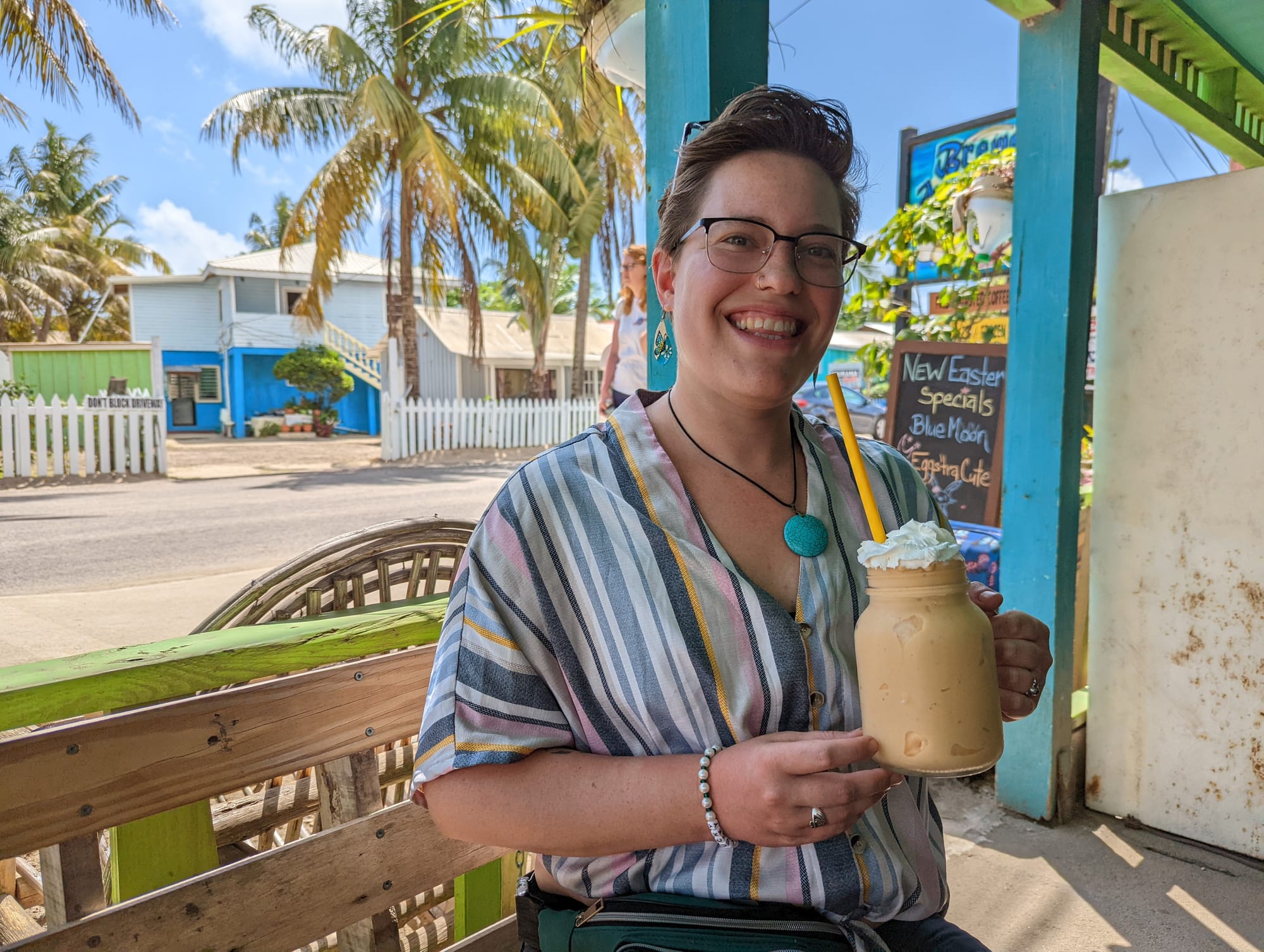
In 2022, I met Seleem Chan, a mariculture specialist from The Nature Conservancy Belize, who collaborates with local ocean farmers to develop and promote sustainable farming techniques.
Another cold email landed me a partnership between Chan and the Heller School for Social Policy, where I was studying social impact business administration. I wrangled together a team of five of the top MBA graduate students to conduct a consultancy in support of the Belize Women’s Seaweed Farmers Association (BWSFA), an incredible group of passionate women making waves in Placencia, Belize.
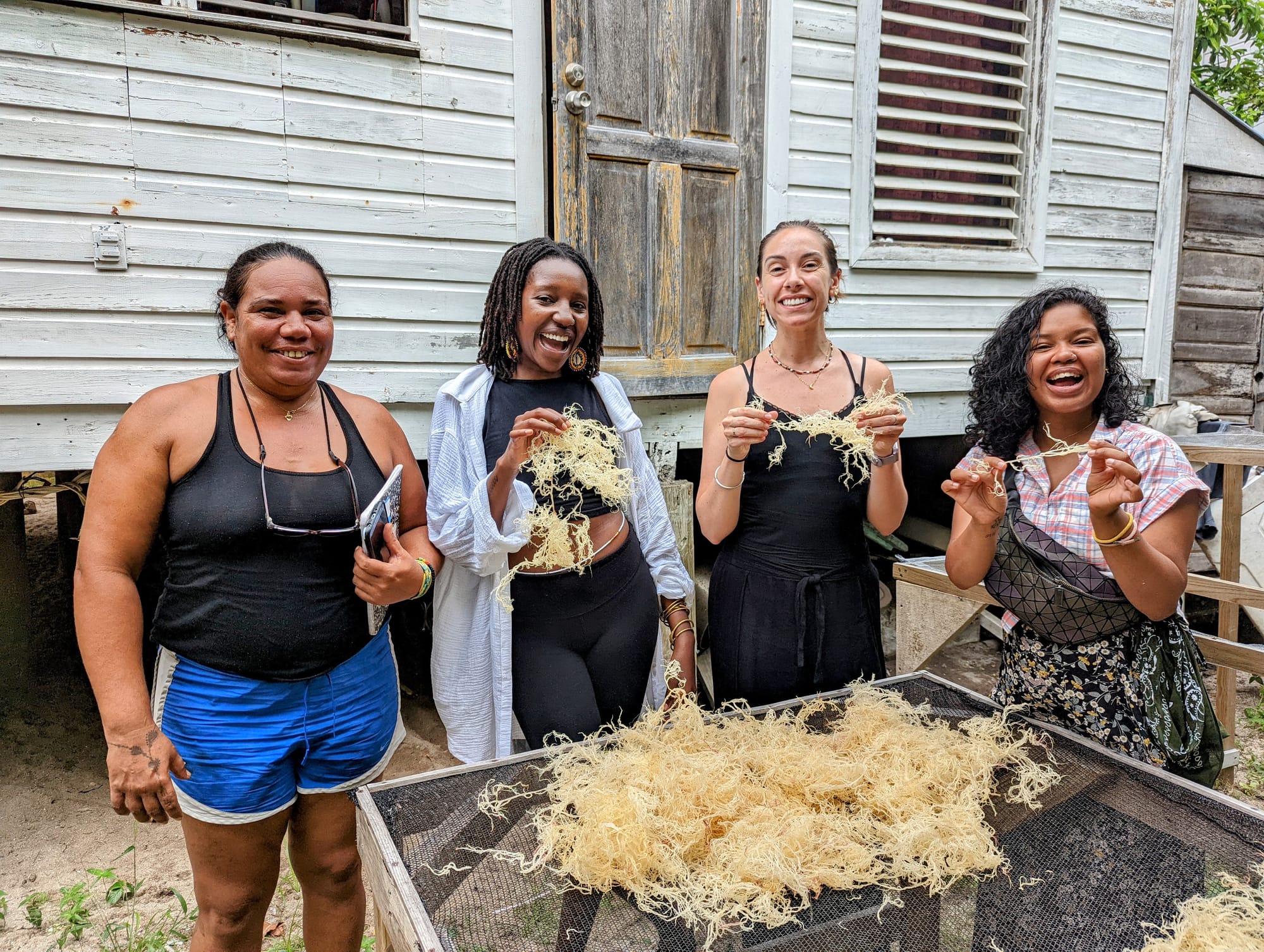
After the global pandemic showcased the challenge of relying on the volatile tourism industry for economic livelihood, communities turned to seaweed farming as a way to supplement family income. Our team worked with the BWSFA women to build capacity and technical literacy in support of farming, processing, and productizing local varieties of red seaweeds. I met so many men and women whose lives were changed by the introduction of small-scale seaweed farming in their communities.
As an international development practitioner, I get giddy when thinking about the triple bottom line impact ocean farming has. A business with a triple bottom line doesn’t just measure success in dollars made, but also how it supports people and protects the planet.
Seaweed farming not only contributes to the United Nations’ Sustainable Development Goals 8 and 14, but also serves as a model for profitable enterprises that have both environmental and social impacts.
And this isn’t just happening in the Caribbean.
In East Africa, Tanzania cultivates thousands of tons of seaweed annually. On the island of Zanzibar, seaweed farming, led predominantly by women, has transformed coastal communities. The practice has empowered women by providing them with their own source of income, enhancing their economic independence and status within the community.
The Future is Blue
So hold on a minute. Can cultivating seaweed really promote gender equality, sustainable development, and healthy ecosystems all at the same time?
That sounds like a win-win-win to me!
Even though the seaweed industry doubled in size between 2005 and 2015, it can still be considered nascent.
Startups and entrepreneurs are dreaming big when it comes to this little algae. Innovators are experimenting with seaweed in beauty products, textiles, biofuel production, and even as biodegradable packaging.
As a lifelong swimmer with curly hair, Pollard tried many ways to keep her hair healthy and beautiful without affecting her desire to swim in the salty open ocean. Like many Belizeans, Jolie Pollard’s grandfather would make seaweed smoothies from the flavorless gel formed when seaweed is boiled. One day, Pollard, frustrated with the state of her hair after another refreshing ocean swim, opened the fridge and grabbed a handful of the seaweed jelly. In desperation, she rubbed it into her hair, not expecting the smooth and shiny results. It was at that moment her haircare company, Ikooma, was born.
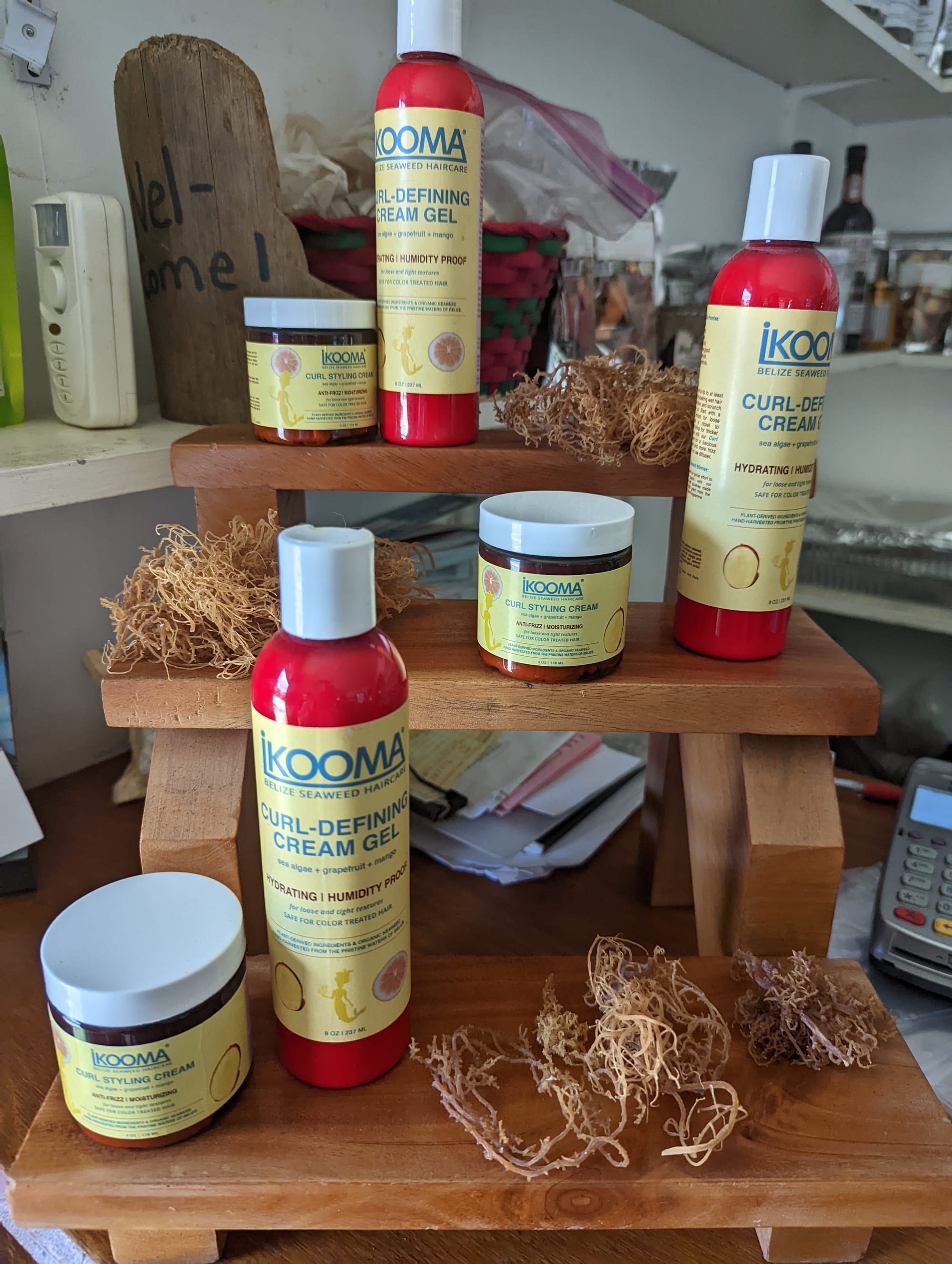
Pollard is one of many who are utilizing seaweed as a hair and skincare product.
Another unique innovation is seaweed’s potential to not replace, but instead to improve traditional agricultural techniques. Studies show that adding a small amount of red seaweed to cattle feed reduces the cow’s methane emissions by as much as 80%! If proven, this could drastically reduce emissions without largely impacting America’s reliance on and love for beef.
And then there are companies like Sway, who are experimenting with the power of seaweed to create home compostable replacements for plastic.
Now, more than ever, it’s time to support a sustainable upscaling of the seaweed industry.
Support the Revolution
Have I sold you on the Seaweed Revolution yet? Whether you’re convinced or still want to learn more, here are some ways to get involved:
- Subscribe to my newsletter: Join me on my journey of discovery, exploring the impact, innovations, and communities behind ocean farming.
- Donate to GreenWave: Support Bren Smith’s mission to train the regenerative ocean farmers in the era of climate change.
- Buy from Atlantic Sea Farms: This Maine-based company sells a variety of kelp products, from burgers to kimchi, that support sustainable ocean farming in the U.S.
I believe in building a thriving, sustainable future – one seaweed farm at a time. Your support can foster a healthier planet, people, and economy.